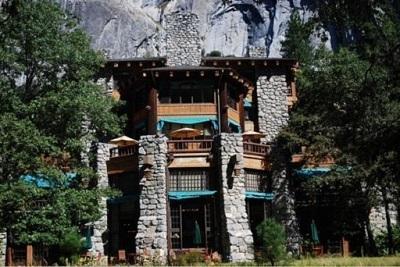
The Ahwahnee Hotel in Yosemite National Park has over $50 million in maintenance needs, and the hotel's name is tied up in litigation of trademark rights by the previous concessionaire/Kurt Repanshek
The $11.9 billion maintenance backlog cited by the National Park Service inflates the true cost of high-priority infrastructure needs and elevates the risk for privatization and corporate giveaways in America’s parks, according to a report by an independent, nonpartisan policy institute.
The analysis, released Friday by the Center for American Progress, noted that only $3.5 billion – or less than 30 percent – of the backlog is labeled as “critical systems deferred maintenance,” and only $1.3 billion is serious enough for the agency to consider a priority for necessary maintenance. In addition, the review found $389 million worth of items in the backlog that it says should be the responsibility of private concessionaires that run businesses in the parks, not taxpayers.
“Too often, anti-conservation members of Congress argue that the National Park Service’s maintenance backlog is insurmountable, and they use this flimsy talking point to argue against protecting other at-risk lands and wildlife,” Nicole Gentile, deputy director with the Public Lands Project at the Center for American Progress and lead author of the report, said in a release. “Congress should focus its infrastructure and maintenance investments on helping the National Park Service protect the natural and cultural resources in our parks, and force for-profit companies in the parks to pay their fair share for upkeep.”
This is the second report in the past two months that urges the Park Service to reconsider how it approaches deferred maintenance. Last month, the Government Accountability Office released a 54-page report that said the Park Service must to do a better job of prioritizing its maintenance needs and stopped short of concluding that the agency is hamstrung by congressional appropriations.
The deferred maintenance list is a tool for Congress to determine how much funding to allocate to national parks. Total funding for the Park Service was $3.25 billion in fiscal year 2015, a 5 percent increase from 2006 when adjusted for inflation. Nearly half of the backlog, $5.9 billion, is for paved roads, and funding for that work generally comes from separate transportation bills. According to data collected by the CAP, Congress in 2015 budgeted more funding per acre to national parks ($39) than other agencies that protect public lands, like the U.S. Fish and Wildlife Service ($32), the U.S. Forest Service ($29), and the Bureau of Land Management ($5).
By including maintenance at facilities like hotels, restaurants, and gift shops operated by concessionaires in the $11.9 billion total, the CAP report argues that Congress and the Trump administration could direct taxpayer funding to these businesses, which grossed $1.14 billion in 2012, instead of trails, historic sites, and conservation projects. Most contracts with the Park Service put the burden of maintenance costs at these facilities on the concessionaires.
“Because concessionaires – rather than U.S. taxpayers – profit from these businesses, the concessionaires should be on the hook for these kinds of maintenance projects. In fact, the contracts already stipulate that concessionaires are responsible for this maintenance, therefore including these costs in the maintenance backlog is misleading at best and a misuse of taxpayer dollars at worst,” the report says.
The Park Service last year told the Center for American Policy that these items are included because taxpayers are ultimately responsible for these costs if a contractor does not pay to maintain a facility.
Maintenance obligations have at times hindered the Park Service’s ability to generate interest in concessions contracts, and when these contracts end, ownership of trademarks for properties can be disputed, most notably at Yosemite National Park, where DNC Parks & Resorts at Yosemite has sued for compensation for intellectual property rights after losing its bid for the park’s concessions contract. The CAP, which says it “does not support or oppose candidates or political parties,” is concerned that President Trump “could allow companies to financially benefit from the national park brand and name” if he intends to pursue a privatization agenda.
The report calls for the Department of the Interior’s Office of Inspector General to investigate concessionaire-operated NPS facilities to ensure that the concession industry is paying its appropriate share of maintenance costs. The brief also argues that Congress should not ignore investments needed in public lands administered by other agencies, including the U.S. Fish and Wildlife Service, the U.S. Forest Service, and the Bureau of Land Management.



Comments
amen !
What this article fails to point out is that all the assets occupied by park concessioners are federally owned. Condition assessments are conducted and deferred maintenance is identified on any assets that will be included in a potential concessions contract. If financially feasible, the cure of the DM is included as part of the contract. However, there are times where the DM is so large it cannot all be addressed through the contract and it becomes the responsibility of the NPS. There are several examples such as the Many Glacier Hotel, Old Faithful Inn, and the Grand Majestic (Ahwahnee) Hotel, where DM, code compliance along with capital improvement needs where so great that it required Line Item Appropriations.
I think that the other point that the article misses is that the DM associated with Concessions occupied assets represents just over 3% of the total DM a number that has been shrinking as the NPS does a better job of negotiating concession contracts and NPS superintendents are holding concessioners accountable for performing the necessary maintenance over the life of the contract.
Fastharv, we share a number of your questions, and are working on a follow-up to the initial report from CAP.